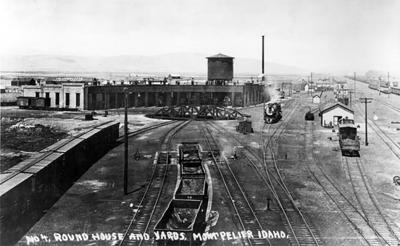
Roundhouse and Yard
Condensed from an article written by Valerie Hayes and published in The News-Examiner 4 March 2020, page 4

Oct. 1903 surveyors arrived in Montpelier and began the work of laying off the ground where the new roundhouse and machine shops were to be built. The evening before, Master Mechanic Dunn was there and conferred with Foreman Carrick as to the method of handling the work while the new house was being built. He said the new plant would be rushed to completion. Everything would be well under way within 10 days or two weeks.
The plans called for a roundhouse of 20 stalls, a big machine and blacksmith shop, and offices, etc. The buildings would be of brick and stone. A big turntable was to be put in, new coal chutes, sand house, and like appurtenances as well. The new buildings were to contain every modern improvement for the handling of and repairing of the company’s engines. The whole plant was to be lighted by electricity. New and larger machinery was to be installed requiring possibly a larger force of men at that point, than was then employed.
The people of Montpelier had waited patiently for the beginning of this work, and now that they were to see the fruition of their hopes, there would be a spirit of progressiveness shown on all sides. It meant the building of new and better buildings, and a general improvement all over the city. The roundhouse and other buildings, exclusive of the depot, called for an expenditure of nearly $100,000, and it took until spring of 1904 to finish the work.
Building of the structures put many thousands of dollars into circulation in the city of Montpelier during the winter of 1903, as the company gave local men the preference in doing the work, and they were paid good wages.
In December of 1963, the News Examiner published an article that read, “Removal of one of the major landmarks of Montpelier is underway at the present time. The brick round house constructed by the Union Pacific Railroad in Montpelier in 1903 is now being removed and only the north end of the unit will remain.